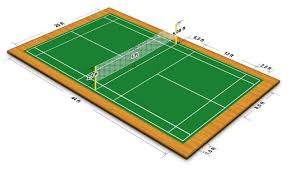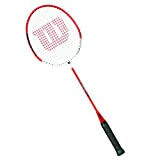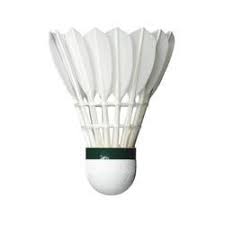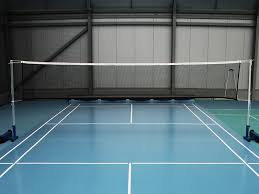
About Badminton
Badminton originated in British India, was a popular game amongst the British Officers. This sport is played using racquets and a shuttlecock, badminton gained popularity due to its simplicity, generally being played as a casual outdoor sport among friends and family members.
Singles and doubles are the two formats of the game. Athlete on each side passes the shuttlecock over the net to the other side with only one stroke over a net. This sport is played over a court with designated boundaries.
The shuttlecock is made of feathers with rubber ends creating a drag force which rapidly decelerates the shuttlecock. The flight of the shuttlecock gives the sport its distinctive nature.
The sport of Badminton is governed over by Badminton World Federation (BWF); they are responsible for conducting tournaments and deciding the rules for the sports.
Badminton Olympic 2020 logo : ![]()
History
Badminton as a game originated in British India, during 1870. In 1992 this sport was introduced as a part of the Olympics having four events. Four years later, mixed-double was introduced as the fifth event in this sport.
Badminton World Federation (BWF), formed in 1934, governs all the tournaments of badminton throughout the world.
This body has five regional confederations as its part each responsible for organising the tournaments in their continents.
Objective
Badminton is played between two opponents or team, the objective of this game is to deceive the opponent by placing the shuttlecock in the opponent’s court or forcing the opponent to commit a foul thus scoring a point. This game follows points and game pattern for deciding the winner.
Badminton has five events
- Men’s Single
- Women’s Single
- Men’s Doubles
- Women’s Doubles
- Mixed Doubles, where a pair of man and women compete as a team.
The athletes participating in this sport should have good hand-eye coordination, with swift movement ability, agile and possessing great stamina, precision and speed. They should also have a sharp mind to fool the opponent with racquet speed and sudden change of direction to acquire points.
The strategy of the players is to make the opponent move more to make opponent tire resulting in a false shot.
About Badminton Court
Badminton court is rectangular divided into two halves. These halves are separated by a net. Courts are marked for both singles and doubles match with lines.
The doubles court is wider than the singles court, but the length of the court is the same for singles and doubles. The width of the doubles court is 20 ft, and the width of the singles court is 17 ft. The full length of the court is 44 ft.
A short service line is marked at about 6 ft 6 inches from the net while long service line marked at 2 ft 6 inches from the back boundary. Height of the net is about 5 ft 1 inch at the ends and dips to 5 ft at the centre.

Equipments
Racquets: Badminton racquets, are made of carbon fibre or steel. They are lightweight and used by players easily over long rallies. They have thin but highly durable strings tied in such a way that they can hit the shuttlecock with much force. They also have a handle for the players to catch. The player can select the grip of the racquets according to their choice.

Shuttlecock: The shuttlecock is a conical high drag projectile made with a base of rubber at the base and embedded with feathers to increase the drag.

Net: Made of nylon fibre to stop the shuttlecock. Attached to the poles in between each halves thus seperating the halves.

How Sport Is Played
- The game starts with a toss of a coin before the match referee, the player winning the toss can decide either to serve or select side. Initially, the score of the opponents are 0-0 and also called love-all.
- When the server serves the shuttlecock should pass over the short service line diagonally to the opponent's court. Violating this rule results in a service fault. A point gets awarded to the opponent with the serve passing on to the opponent.
- The server serves from the right court when the score of the server is either 0 or an even number. In case the score of the server is odd, the server serves from the left court.
- In doubles, when a server wins a rally, the same player continues to serve, but the players change the side of the court, so that the server now serves to a different opponent.
- In doubles, if the opponents win the rally and their new score is even, the player in the right service court serves; if odd, the player in the left service court serves. The player's service courts are determined by their positions at the start of the rally, not by where they were standing at the end of the rally.
- Three games are played and the athlete winning two games is declared as the winner. Each game is further divided into 21 points. The first athlete reaching 21 points is awarded the game unless there is a tie.
- In a game when both the players are at 20 all, the player who gains a 2 point lead first, wins that game.
- In case the game persists beyond 20 points, and no player can attain a 2 points lead, at 29 all, the player winning the 30th point, wins the game.
Rules Of Badminton
- Violation of any rules results in a awarding of a point to the opponent.
- A player should try to deceive the opponent and make the shuttle land on the opponent’s court. Landing the shuttle on the line is considered to be landed in the court.
- A player should wait for the opponent to be ready before serving.
- A player cannot hold his racquet near the net. He should always hold the racquet from the handle.
- Both the feet of the player should be touching the ground during the serve. No part of the player’s feet should be touching the line.
- Player missing the shuttle during the serve is not considered as a fault.
- Hitting the shuttle twice by the same player is not allowed.
- The shuttle, at the instant of being hit, should be kept lower to the servers’ waist.
- The server should not move forward as he serves.
- The opponent should not hinder/obstruct the server during the serve.
- A serve or shot should not lands outside the court boundaries or pass under the net.
- A player should not touch the net by their body or racquet when the shuttle is in play.
- A player should try to deceive the opponent and make the shuttle land on the opponent’s court. Landing the shuttle on the line is considered to be landed in the court.
- If a lets is called by the referee, the rally is stopped with no increment in the score. The point is re-played between the players. Lets is called by the referee when there are some unexpected disturbances (like a light going off or a shuttle from another match played in the adjacent court lands in the match court.)
Scoring System
- A player winning a rally by deceiving the opponent or forcing the opponent to commits a foul adds a score to his name.
- A match consists of best of three games, each game consisting of 21 points.
- Every time a point has scored the player winning the point serves.
- The player winning a game serves first in the next game.
- An interval of one minute is awarded to the player after each game.
- If the game extends to the third game, then the player's changes end when a player reaches 11 points.
World Rankings
- World ranking based on categories :
- Men's Singles
- Kento Momota

- Chou Tien Chen

- Anders Antonsen

- Women's Singles
- Tai Tzu Ying

- Chen Yu Fei -

- Akane Yamaguchi

- Men's Doubles
- Marcus Fernaldi Gideon, Kevin Sanjaya Sukamuljo

- Hendra Setiawan, Mohammed Ahsan

- Li Jun Hui, Liu Yu Chen

- Women's Doubles
- Chen Qing Chen, Jia Yi Fan

- Yuki Fukushima, Sayaka Hirota

- Mayu Matsumoto, Wakana Nagahara

- Mixed Doubles
- Zheng Si Wei, Huang Ya Qiong

- Wang Yi Lyu, Huang Dong Ping

- Dechapol Puavaranukroh, Sapsiree Taerattanachai





 (1 votes, average: 5.00 out of 5)
(1 votes, average: 5.00 out of 5)


